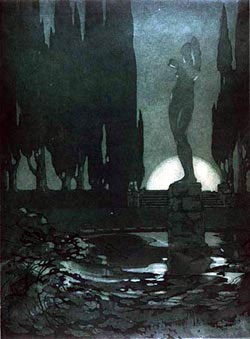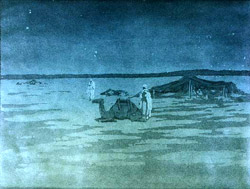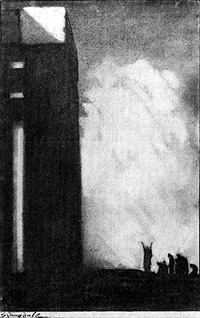John & Katharine Maltwood Collection
| View the Collection |
History of the Collection |
John & Katharine Maltwood |
Information Resources |
Background Maltwoods as Collectors Cultural Context The Arts and Crafts Movement in Victoria
The Collection Museum at "The Thatch" Notable B.C. Artists in the Maltwood Collection - Introduction - Emily Carr - William Percy Weston - Charles John Collings - Ina D.D. Uhthoff - Hildegarde Wyllie - Daisy R. Swayne & Emily Schofield - Elizabeth Duer - Barbara Woodward - Stella Langdale History of the Maltwood Collection (ppt 14.6 MB)
About Us Contact Us Visit Us Site Map

Notable B.C. Artists in the Collection - Stella Langdale | ||||||
|
Born in Staines, Middlesex, Stella Langdale attended the school of art at Brighton for several years, followed by a period of study under Frank Newbury and Maurice Grieffenhagen at the Glasgow School of Art. This sound technical training allowed her to experiment in oils, watercolour, charcoal, pastels, etching techniques and sculpture. In inspiration she followed the sublime landscapes of the British Romantic tradition and the visionary works of William Blake, John Martin and Samuel Palmer. For subject matter Stella Langdale preferred to travel abroad wandering from place to place sketching and absorbing the history, poetic beauty and mystery of remote areas in North Africa, Italy and France. In this wanderlust and love of adventure she found a freedom and a different interpretation of life which is reflected in all her imaginative work.
Stella Langdale liked to use charcoal for drawing; seeing things in simple tone and mass. This lead to her interest in the tonal possibilities of etching and aquatint which became her favourite medium after 1915.98 In the next few years she produced a large number of small aquatint plates. Several were of Italian and African subjects while others were imaginative and musical such as The Incarnation of the Snow, Moonlight Sonata, The Dream Garden and Nocturne. The latter is among the Maltwood art treasures and shows a solitary statue set in a dark garden pond among sombre groups of cypresses. It is typical of Stella Langdale's fascination with atmospheric effects. The ghostly reflections, dusky shadows and silhouettes of moonlight are used to create a dreamy, mystical quality. As in the symbolism of James McNeill Whistler, her pictures frequently took musical forms - Sonata, Symphony, Harmony, Nocturne - translating the spiritual evocations of music into art. Of Stella Langdale's desert themes, taken from her sojourns in North Africa, the Maltwoods purchased Arab Tents of the Desert, Biskra, The Garden of Allah. Silhouetted against a deep, star-lit, tropical night a few motionless figures stand with camels and tents amid a vast expanse of desert. In her diary Stella Langdale described the spectacular beauty of such desert evenings where sand hills "blossom like a rose" as the sun sets and how "suddenly the piercing cry of a muezzin breaks the extraordinary silence of the North African night, 'Allah is Allah'..." This last call to prayer at dusk explains her title in this piece, "The Garden of Allah".
Stella Langdale won her first public recognition in art as an illustrator of books. She was associated with the John Lane Publishing Co. and Dodd, Mead & Co. for nearly twenty five years producing drawings for Edmund John's Symphonie Symbolique, John Henry Newman's Dream of Gerontius and Stephen Phillips' Christ in Hades.99 Her illustrations to the 1922 edition of Francis Thompson's Hound of Heaven were particularly praised for the way she captured the spirit of the poem putting "into concrete form the wonderful visions of the poet, without losing anything of the grandeur or vastness."100 Francis Thompson's (1859-1907) mystical catholic philosophy was well suited to Stella's own moral preoccupations and melodramatic imagination. The drawings are dramatically dark and fantastic with a broad treatment of shadows and silhouettes. They show silent, veiled figures, great monolithic forms, star-lit skies streaming with light, figures diving through space or rising in swirling clouds and horse-drawn chariots struggling skyward from thundering sea-storms. As in the works of John Martin the settings are often vast, giving a sense of cosmic scale, and dwarfing humanity to insignificance. In all the awesome forces of nature are suggested expressing the poem's preoccupation with the intense energy of divine creation. Several of the drawings show remarkable similarities to Katharine Maltwood's sculptural forms. The archaic qualities of The Holy Grail are recalled for instance, in the priestly figures of archangels illustrating "I shook the pillaring hours and pulled my life upon me." The Maltwoods acquired a charcoal drawing by Stella Langdale which is also notably close in style to these illuminations. Here a huge megalithic monument towers above a small group of pre-historic worshippers silhouetted far below in the evening sky. In its awe-inspiring, super-human air it is typical of the artist's apocalyptic visions of great ancient civilizations, shadowy and immense. Such dreams dominated her prose descripions like that of "Lost Atlantis" where she writes: "It makes one think of pagan priests and astrologers consulting the stars, sacrifices and huge banqueting halls where harpists sang of death, love and battle, processions and wild music on conch shells. The distant roll of thunder echoes among the hills, the world grows dark, the sea rises, 'wine dark'. It is a cyclopaean saga." As an artist Stella Langdale was always intensely preoccupied with the past. She imagined a vital and exciting era, a golden age, which due to evil and moral decay was lost forever in some catastrophic disaster. She had little time for the present age and hoped, like Katharine Maltwood, that the spiritual message and wisdom embodied in the Glastonbury Zodiac would revitalize society. Such romantic longings pervade her writings, in prose and poetry, which describes her favourite sketching retreats abroad.
In particular she was captivated by Italy's by-gone eras and adds nostalgia and hallucinatory intensity to her accounts of the ancient architecture and legends surrounding Naples, Rome, Venice, Viareggio, Assisi and San Vigilio. These reveal her constant enchantment with the sea, moonlight, intangible shadows, ancient mysteries and cataclysmic events. While sketching the evening shadows on ancient byways and lonely deserted ruins, she tells how she found "staring at them one becomes a ghost oneself looking into the past." Old monastery churches were a favourite theme as a charcoal in the Maltwood Collection reveals. Like Samuel Palmer, she sought to enrich the actual present by a reference to the past and by expressing the mystery which dwells in the nature of things in a serene and intimate harmony. In later years Stella Langdale exhibited regularly at the foremost British galleries and the Paris Salon and continued to travel, visiting Italy annually for almost twenty years. She came to Victoria in 1940 with her great companion Florence Bayham, a noted pianist. In the next few years while staying at The Empress Hotel or on extensive sketching trips throughout the Province Stella Langdale produced numerous oil and watercolour sketches. Many were seascapes and views of Victoria harbour where she found the clear, bright sunset similar to that in Venice. She had always been enchanted by the power of the sea and the great sailing ships of old. In Victoria she sketched and wrote romantically of the old clipper hulls since converted into barges by Island Tug Co.: "In such ships lies romance, at night they seem to edge closer together for company...they change into phantom ships with clouds of sail set and leaning on the wind. Legions of ghosts surely haunt these once tall ships...they carry imperishable memories." Many of her British Columbia works together with a few European scenes were exhibited at the Little Centre in Victoria in 1946. The titles reflect her continued obsession with the shadows of dusk and moonlight impressions - Silent Hour; Evening Glow, Olympics; Rising Moon; Blue Night, Victoria; Low fog, midnight, Victoria; The Last Gleam; Moonlight sky over Cathedral, Victoria. In pursuit of such images she often used a technique involving a small plate of darkened glass which gave daylight scenes a glimmering moonlight effect. Stella Langdale, like her friend Katharine Maltwood, was inspired by the spiritualizing force of the forests and mountains of British Columbia which she found "full of savage primeval subjects."101 A small landscape in the Maltwood Collection dates from this period and makes a marked contrast to her dark aquatints and watercolours. Working in oils the palette is bright, the colours luminous and the brushwork broad and simple. Her African themes were also not all sombre as can be seen in The Roofs of Tunis, a small oil purchased by the Maltwoods from the 1946 exhibition. Here the vibration of heat and light is suggested with cool blue shadows cast from dense yellowish domes and roof tops. Stella Langdale suffered from severe arthritis and was continually hampered by its crippling effects. Around 1950 she moved south to Santa Barbara, California where she continued to sketch and correspond with the Maltwoods until her death in the late 1950's. That she and Katharine Maltwood shared similar aims is displayed even more clearly in "An Appreciation" written by the latter for Stella Langdale's exhibition in Victoria in 1946. Here Katharine Maltwood extolled the artist's sound technical training and continued in words which could well describe her own career: "She is also a visionary. Even if 'subject' is nothing to art - as had been so ably demonstrated by Lawren Harris recently - to Stella Langdale every bush is a 'burning bush of God' and light - the 'light of the Holy Grail'; her ultimate desire is to translate the divine dream behind the veil: a land of tender and delicate solitudes. She has reached out above scholasticism to something of the spirit beyond."
All content on this page is copyright © 7 February, 2006 |
||||||


